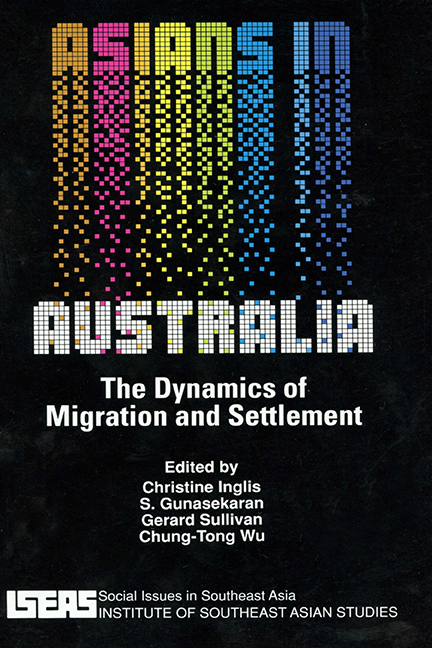Book contents
- Frontmatter
- Contents
- List of Tables
- List of Figures
- Introduction
- 1 China's Policy Towards Migrants, 1842–1949
- 2 Japanese Emigration Policy, 1880–1941
- 3 The “New” Migration and Australian Immigration Policy
- 4 Patterns of Settlement in Australia of Indochinese Refugees
- 5 Labour Market Outcomes Among the Chinese at the 1986 Census
- 6 Is There An Asian-Australian “Brain Drain”?
- 7 The “New” Migration of Asian Skills and Capital to Australia
7 - The “New” Migration of Asian Skills and Capital to Australia
Published online by Cambridge University Press: 21 October 2015
- Frontmatter
- Contents
- List of Tables
- List of Figures
- Introduction
- 1 China's Policy Towards Migrants, 1842–1949
- 2 Japanese Emigration Policy, 1880–1941
- 3 The “New” Migration and Australian Immigration Policy
- 4 Patterns of Settlement in Australia of Indochinese Refugees
- 5 Labour Market Outcomes Among the Chinese at the 1986 Census
- 6 Is There An Asian-Australian “Brain Drain”?
- 7 The “New” Migration of Asian Skills and Capital to Australia
Summary
Introduction
Since World War II, Australia and other countries on the Pacific Rim, such as Canada, the United States and New Zealand, have again become important destinations for Asian migrants as they were during the earlier parts of the present century. The composition and volume of the recent migration stream have, however, shifted significantly. Australia, like the other major destinations on the Pacific Rim, has thus experienced quite dramatic changes in the origins of its settlers. The volume and composition of new migrants have important implications for policy as well as for theory and research.
What is occurring in Australia is observable in other major destination areas as well although it is by no means clear that the impact on the destination nations would be the same. In Australia, the new wave of migration has a number of characteristics. Increasingly, the migrants are the skilled, the professionals and the entrepreneurs. Like other countries, Australia has a programme to attract business migrants with a specified minimum investment. In other words, the migration stream involves both human and financial resources flowing from the Asian nations to Australia. The number of migrants are known but the size of the financial resource transfer is less certain. The social implications of the new migration flow is also important not only because of the historical antipathy towards Asians in Australia, but also because of the new pattern of “sojourners” among the new migrants. In a reversal of the “sojourner” who left his family behind in the place of origin and wanted only to save enough money in order to go home financially secured, the new sojourner leaves his family in the destination country and often ventures back to the place of origin to carry on his business there. Hence, it is important to delve in detail into the new migration behaviour in order to establish the characteristics of the new migrants.
The four major Pacific Rim destination areas for Asian migration are Australia, Canada, New Zealand, and the United States. By the late 1960s and certainly by the early 1970s, the composition of migrants to these countries had exhibited extraordinary changes.
- Type
- Chapter
- Information
- Asians in AustraliaThe Dynamic of Migration and Settlement, pp. 193 - 230Publisher: ISEAS–Yusof Ishak InstitutePrint publication year: 1992



